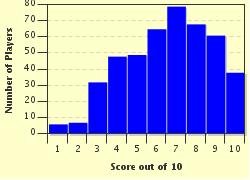Quiz Answer Key and Fun Facts
1. In Operation Fortitude South (which was part of Operation Bodyguard), a fictitious army group was established in Kent, England, to deceive the Germans that the invasion of northern France would come at the Pas de Calais. What was this fictitious army group called? (Hint: All three wrong answers had active roles in the invasion of France in June 1944 and subsequent breakout.)
2. In Operation Fortitude South, who was the real-life general who was put in charge of this fictitious army group and made many visible appearances?
3. In Operation Fortitude South, what steps were taken to deceive the Germans that the invasion of northern France would come at the Pas de Calais?
4. In Operation Fortitude South, what pieces of military equipment were faked with inflatable rubber replicas, which were intended to deceive any German airborne surveillance?
5. In Operation Fortitude South, what German army officer captured in North Africa was released from captivity in England, but was driven to his return ship by a particular route so he could pick up on "clues" and hopefully report them back in Germany?
6. In Operation Fortitude North (which was also part of Operation Bodyguard), what country was the supposed object of invasion?
7. What was the name of the British double agent whose radio reports from Britain so completely fooled Hitler and the Germans that he was awarded the German Iron Cross?
8. In Operation Mincemeat, the objective was to trick the Germans about the route the Allies would take when Italy was invaded from North Africa. A drowned man, who was made up to look like he was a courier shackled to a briefcase, was positioned in the ocean so he would wash ashore in Spain. The briefcase contained documents suggesting the invasion route would not be through Sicily, but instead through what route?
9. What body of water did British stage magician and illusionist Jasper Maskelyne appear to make disappear to German bombers and mine layers by using floodlights and a rotating cone of reflectors to give a nine-mile-wide pulsing effect (like a modern-day strobe lamp)? After he joined the army, he was stationed in North Africa with the British Eighth army. (Hint: This body of water touches the Mediterranean Sea.)
10. What city did Jasper Maskelyne's team misdirect German bombers away from?
Source: Author
root17
This quiz was reviewed by FunTrivia editor
bloomsby before going online.
Any errors found in FunTrivia content are routinely corrected through our feedback system.

